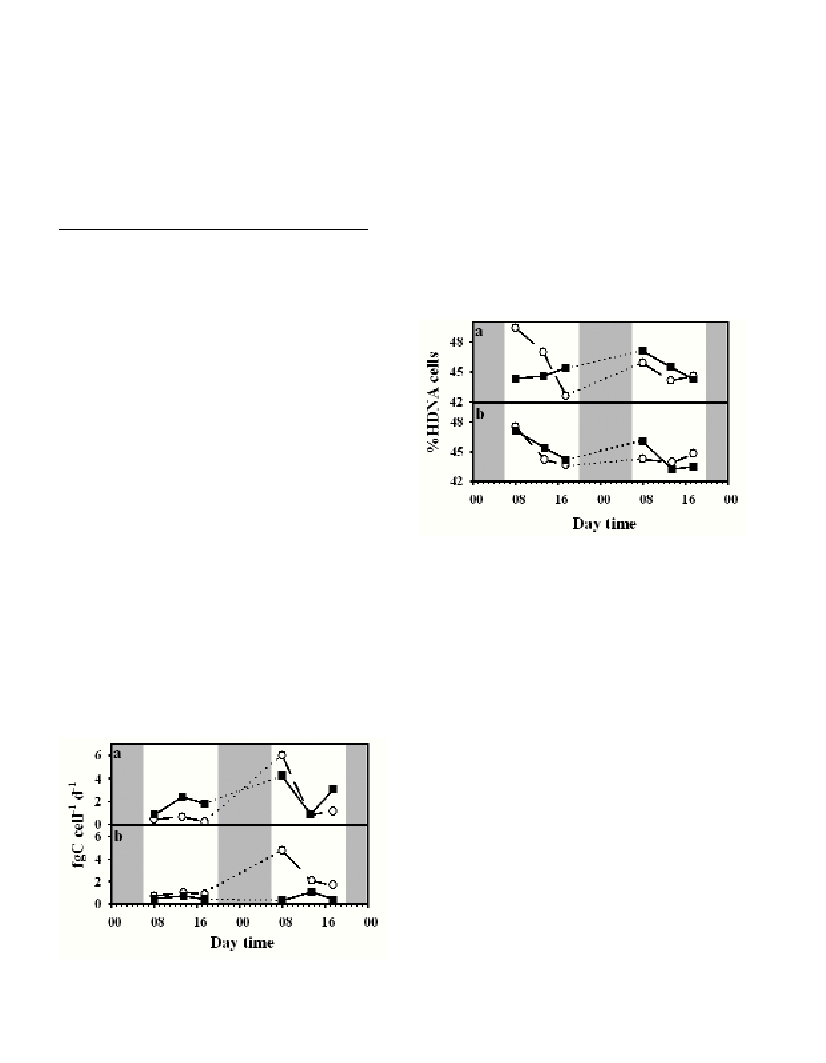Rapp. Comm. int. Mer Médit., 37,2004
291
BACTERIAL ACTIVITY IN THE SURFACE MICROLAYER OF THE OPEN MEDITERRANEAN SEA
Eva Sintes * and Gerhard J. Herndl
Department of Biological Oceanography, Royal Netherlands Institute of Sea Research, PO Box 59, NL-1790 AB Den Burg,
The Netherlands - * esintes@nioz.nl, herndl@nioz.nl
Abstract
Diel dynamics in the activity and viability of bacterial cells were studied in the surface microlayer (SML) and the underlying water layer
(UWL) of the open Mediterranean Sea, following a drifting buoy. Bacterial abundance was rather stable and only slightly higher in the
SML as compared to the UWL. The cell-specific activity of bacteria was variable, however, and diel cycles of bacterial activity showed a
decrease in the percentage of active cells and a slight increase in the percentage of cells with compromised cell membranes during the day,
which might be related to UV-induced damage.
Keywords: Bacteria, sea surface microlayer, activity, viability
Introduction
The SML is a unique microenvironment characterized by the
accumulation of dissolved and particulate inorganic and organic
matter (1). Accumulation of organisms (2, 3) and enhanced enzymatic
activities have been reported for these waters (4). Essentially all the
information available thus far on the SML originates from studies
conducted in coastal areas, lakes or ponds, but diel dynamics of the
activity of organisms of the open sea SML are still lacking.
Material and Methods
To determine the diel dynamics of the microorganisms in the SML
of open sea areas, we sampled the SML and the UWL waters over diel
cycles, following a drifting buoy in the open Mediterranean Sea. The
first sampling (29-30 Sept. 03) was characterized by a calm sea state
and bright sunshine while the second diel cycle (4-5 Oct 03) was
preceded by a day with wind force 7 and white caps, calming down
overnight prior to sampling. We measured the abundance of bacteria
by ?ow cytometry distinguishing high and low-DNA bacteria, CTC+
cells (highly active cells), and cells with compromised cell
membranes. Bacterial production via
3
H-leucine uptake was
measured as well, along with some basic chemical parameters
(inorganic nutrients, dissolved organic carbon, DOC).
Results and Discussion
Bacterial abundance was rather stable, ranging between 2.97 and
4.29 x 10
5
cells ml
-1
during the first sampling, and between 4.67 and
6.56 x 10
5
cells ml
-1
during the second diel cycle, decreasing slightly
around noon and being higher in the SML with one exception. The
specific production of bacterial cells, calculated as the bacterial
production per cell, was variable (Fig. 1), ranging from 0.20 to 5.99
fgC cell
-1
d
-1
with no clear diel pattern. Other factors related to the
activity and viability of the microbial cells showed distinct diel
dynamics. The percentage of high-DNA cells generally decreased
during the day and increased over night (Fig. 2). The respiratory
activity per CTC+ cell decreased around noon, while the percentage
of cells with a compromised cell membrane increased concurrently.
The higher biomass of microorganisms in the SML, as found
elsewhere (2, 3), was related to the higher nutrient and DOC
concentrations. The decrease in bacterial activity around noon is most
likely mediated by the damaging effect of UV radiation on bacteria (5)
and/or photolysis of DOM (6) forming radicals.
Fig. 2. Diel dynamics in the percentage of high-DNA cells. Legend as in
Fig. 1.
Acknowledgements. ES was supported by a fellowship from “Sa
Nostra”, Illes Balears.
References
1-Liss, P.S., and Duce, R.A. (eds.), 1997. The sea surface and global
change. Cambridge Univ. Press (UK), 534 p.
2-Williams, P.M., Carlucci, A.F., Henrichs, S.M., van Vleet, E.S.,
Horrigan, S.G., Reid, F.M.H., and Robertson, K.J. 1986. Chemical and
microbiological studies of sea-surface films in the southern Gulf of
California and off the west coast of Baja California. Mar. Chem.,19: 17-
98.
3-Falkowska, L. 2001. 12-hour cycle of matter transformation in the sea
surface microlayer in the offshore waters of the Gdansk Basin (Baltic Sea)
during spring. Oceanologia, 43: 201-222.
4-Kuznetsova, M., and Lee, C. 2001. Enhanced extracellular enzymatic
peptide hydrolisis in the sea-surface microlayer. Mar. Chem.,73: 319-322
Herndl, G.J., Muller-Niklas, G., and Frick, J. 1993. Major role of
ultraviolet-B controlling bacterioplankton growth in the surface layer of
the ocean. Nature, 361: 717-719.
5-Obernosterer, I., Reitner, B., and Herndl, G.J. 1999. Contrasting effects
of solar radiation on dissolved organic matter and its bioavailability to
marine bacterioplankton. Limnol. Oceanogr.,44: 1645-1654.
Fig. 1. Diel dynamics of the specific production of bacteria in the surface
microlayer (circles) and the underlying water layer (squares) during (a)
the first (29-30 Sept.) and (b) the second diel cycle (4-5 Oct.) of
sampling.

